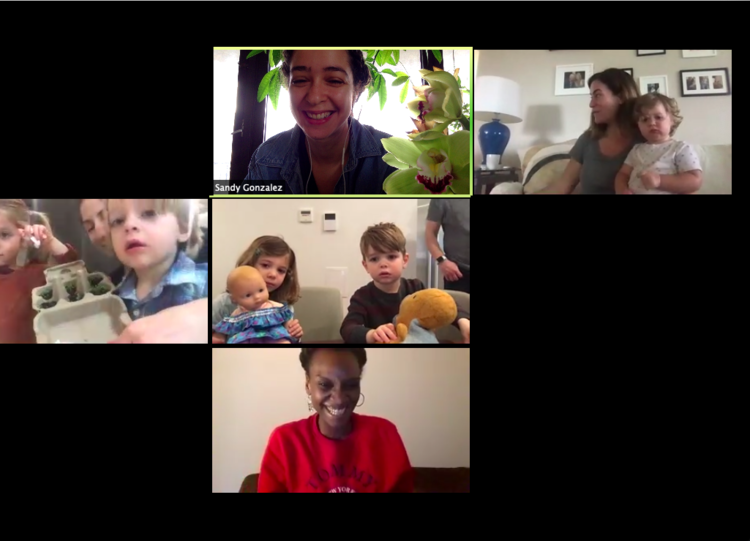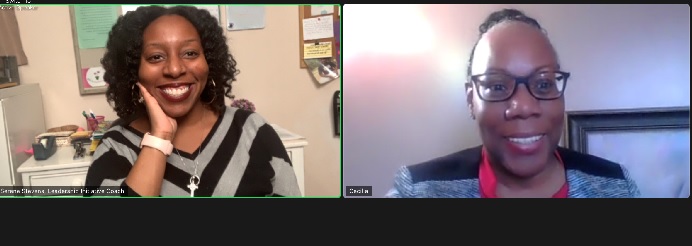Since the statewide shutdown, our class rosters have grown significantly, but not in the way you might expect. Although our preschool is no longer accepting new enrollees, we find ourselves serving more children as our students invite their siblings to join our virtual programming.
“Lucy, it’s time for school!” three-year-old Sam calls off-screen to her 18-month-old sister who quickly waddles over moments later. “Can Harry come, too?” four-year-old Ellen asks on behalf of her three-year-old brother who has already dutifully set himself up in the camera frame. “Harry, show them your drawing,” Ellen instructs.
To date, all of our students’ siblings have made appearances during our virtual playdates. Some siblings stay the whole time, participating in projects and discussions. Others just poke their heads in to watch for a few minutes or to wave hello.
At first glance, this may seem like a problem – more children to manage, more voices on the video call. But at Brooklyn Schoolhouse, our preschool teachers have approached this situation as an opportunity, working to integrate siblings into instruction. “Simon, can you help your sister open the marker?” “Max, that was kind of you to let your sister, Mary, share first.” Our teachers have embraced siblings as an integral part of their virtual lessons, referring to each sibling by name and allocating time for them to share during class discussions.
By including siblings in our virtual programming, our teachers are creating ample learning opportunities. Older siblings have the chance to model, scaffold, lead, demonstrate compassion, and share with their younger siblings. Younger siblings experience tender moments of pride as they watch, listen to, and learn from their older siblings.
Although we are apart, including siblings in our virtual programming has brought a closeness to our sessions. Each time a meaningful sibling interaction takes place during a virtual meeting, a sense of community and belonging oozes through the screen. Our students’ faces light up when their siblings contribute. Their eyes open wide and smiles creep across their faces.
Prior to the pandemic, adding a new student involved layers of bureaucracy. From collecting medical records and emergency contact information to maintaining appropriate age and teacher ratios, a lot goes into accepting a new enrollee. Now, all a child has to do is walk up to the screen and they’re part of our class.
“Is it okay that both of my kids join the Zoom calls?” a parent asks with trepidation. “Of course!” I reply.
Siblings have brought positivity and a firmer sense of belonging to our virtual programming, which raises some important questions about the future. How can we carry over the benefits of sibling, familial, and mixed age interactions into the school year? When we reopen, how can we promote long-lasting connections between siblings?
What are some ways that you promote sibling engagement at your school? Have you been able to engage siblings in your virtual programming? If so, what benefits or challenges have arisen?
Melanie Muskin is the Education Director at Brooklyn Schoolhouse, an independent preschool, and a member of the New York Early Childhood Professional Development Institute’s Leadership Initiative. Check out her recent blog post on managing distance learning in preschool.




As perschool teacher I can appreciathe insight from this post. . Allowing the siblings of your student’s to join the class is certainly an added benefit of a virtual class.
I loved reading how your school embraces siblings. I too have found that Zoom calls create a built in family aspect to learning. Kids learn from each other and you have highlighted the strengths of students inviting their siblings to join their class.
Thank you for sharing! I hear similar stories from some of our teachers. Truly heartwarming. Though it is not official, we are welcoming the whole family and in a sense, it is much easier because there is no ratio issue.
I am loving observing all the siblings on together, even the baby siblings in the bouncer next to the child.And twins are enjoying being part to each other’s classes when they have been in different ones in the school year. Also, the parents and caregivers are part of our classes in a way that is new. We try to include them as much as possible as well.
Wow! I had never thought that this would be possible – the welcoming of siblings in a way that is easy and offers so much for the (enrolled) student! How human! You have really opened my eyes to the possibilities and raised questions to be explored. Thank you.
What an important reflection on the lessons we can take from this time. Siblings allow children some bit of the in-person social interactions they are missing right now, and the validation and facilitation of these interactions by your teachers reveals all there is to learn and grow from these relationships. It seems well-worth considering how to carry this forward once schools re-open.
Melanie, your post highlights one of the many unexpected benefits of this new virtual world.
I also love your question asking how we can bring forth the welcoming of siblings to our classrooms when we move back into our schools.
It’s like having a multi-aged classroom, however this one is composed of family members. Perhaps the original multi-aged classroom.
Thanks for sharing this “sibling” perspective.
Steve
I don’t have children but I admire parents making the Zoom-lifestyle work! and it’s an interesting point that this is a now a bonding opportunity for siblings.